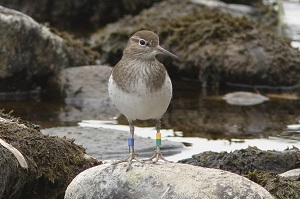Inverness College UHI research could shed light on decline of Scottish wading bird
Inverness College UHI has collaborated with the Highland Ringing Group to learn more about the migration routes and wintering grounds of one of Scotland’s wading birds.
Common sandpipers breed along upland rivers and lakes in the UK, but sadly, numbers have declined by 21% across Europe. Breeding success remains high, so it is believed the cause lies in the birds’ migration route or wintering grounds. Despite the ringing of more than 22,000 common sandpipers across the UK, little is known about their migratory route and wintering grounds once they leave Europe.
Members of the Highland Ringing Group tagged common sandpipers with small geo-locators in a bid to find out where the birds migrate to for the winter and what routes they take to get there. Geo-locators record light-level data that can be used to estimate their locations, but early analyses of this type of data haven’t been specific enough to identify the particular wintering ground.
Ornithologist Dr Ron Summers collaborated with Dr Louise de Raad, research fellow at Inverness College UHI, on a new analytical method. This method was able to provide more precise information on the sandpipers’ movements than was previously possible, tracking the tagged birds via Spain and Portugal to wintering grounds in Guinea-Bissau, West Africa.
Dr de Raad explained: “From this new information, we identified Guinea-Bissau as the location where the majority of Scottish common sandpipers migrate to. Now we have a better understanding of their journey, we are one step closer to finding out why their population is in decline.”
Dr Summers added: “This is a really big breakthrough as before we weren’t able to pinpoint their location in West Africa. Now we can look at the difficulties and challenges they face on their journey and at these wintering grounds, and how these might impact on their survival. For example, we know that coastal Guinea-Bissau is an area of enormous mudflats bordered with mangroves. Some of these areas are being turned into rice fields, so loss of habitat could be a factor. We also now know from analyses of weather data by meteorologist Norman Elkins, that the birds face strong cross and head winds on their northward migration from West Africa. Therefore, poor weather in the spring may lead to lower return rates to their Scottish breeding grounds.”
The results of this study have been accepted for publication in the Journal of Avian Biology.
